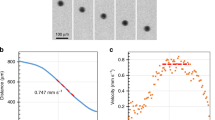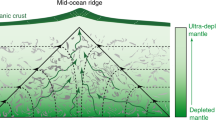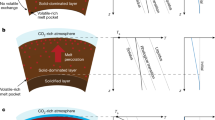Abstract
The source rocks for basaltic lavas that form ocean islands are often inferred to have risen as part of a thermal plume from the lower mantle. These rocks are water-rich compared with average upper-mantle rocks. However, experiments indicate that the solubility of water in the dominant lower-mantle phases is very low, prompting suggestions that plumes may be sourced from as-yet unidentified reservoirs of water-rich primordial material in the deep mantle. Here we perform high-pressure experiments to show that Al2SiO4(OH)2—the aluminium-rich endmember of dense, hydrous magnesium silicate phase D—is stable at temperatures extending to over 2,000 °C at 26 GPa. We find that under these conditions, Al-rich phase D is stable within mafic rocks, which implies that subducted oceanic crust could be a significant long-term water reservoir in the convecting lower mantle. We suggest that melts formed in the lower mantle by the dehydration of hydrous minerals in dense ultramafic rocks will migrate into mafic lithologies and crystallize to form Al-rich phase D. When mantle rocks upwell, water will be locally redistributed into nominally anhydrous minerals. This upwelling material provides a potential source for ocean-island basalts without requiring reservoirs of water-rich primordial material in the deep mantle.
This is a preview of subscription content, access via your institution
Access options
Subscribe to this journal
Receive 12 print issues and online access
$259.00 per year
only $21.58 per issue
Buy this article
- Purchase on Springer Link
- Instant access to full article PDF
Prices may be subject to local taxes which are calculated during checkout




Similar content being viewed by others
References
Bolfan-Casanova, N. Water in the Earth’s mantle. Mineral. Mag. 69, 229–257 (2005).
Ardia, P., Hirschmann, M. M., Withers, A. C. & Tenner, T. J. H2O storage capacity of olivine at 5–8 GPa and consequences for dehydration partial melting of the upper mantle. Earth Planet. Sci. Lett. 345, 104–116 (2012).
Pearson, D. G. et al. Hydrous mantle transition zone indicated by ring-woodite included within diamond. Nature 507, 221–224 (2014).
Bolfan-Casanova, N., Keppler, H. & Rubie, D. C. Water partitioning between nominally anhydrous minerals in the MgO–SiO2–H2O system up to 24 GPa: Implications for the distribution of water in the Earth’s mantle. Earth Planet. Sci. Lett. 182, 209–221 (2000).
Bolfan-Casanova, N., Keppler, H. & Rubie, D. C. Water partitioning at 660 km depth and evidence for very low water solubility in magnesium silicate perovskite. Geophys. Res. Lett. 30, 1905 (2003).
Dixon, J. E., Leist, L., Langmuir, C. & Schilling, J-G. Recycled dehydrated lithosphere observed in plume-influenced mid-ocean-ridge basalt. Nature 420, 385–389 (2002).
Saal, A. E., Hauri, E. H., Langmuir, C. H. & Perfit, M. R. Vapour undersaturation in primitive mid-ocean-ridge basalt and the volatile content of Earth’s upper mantle. Nature 419, 451–455 (2002).
Ohtani, E. Water in the mantle. Elements 1, 25–30 (2005).
Nishi, M. et al. Stability of hydrous silicate at high pressures and water transport to the deep lower mantle. Nature Geosci. 7, 224–227 (2014).
Ringwood, A. E. & Major, A. High-pressure reconnaissance investigations in the system Mg2SiO4–MgO–H2O. Earth Planet. Sci. Lett. 2, 130–133 (1967).
Liu, L-g. Effects of H2O on the phase behaviour of the forsterite–enstatite system at high pressures and temperatures and implications for the Earth. Phys. Earth Planet. Inter. 49, 142–167 (1987).
Ghosh, S. & Schmidt, M. W. Melting of phase D in the lower mantle and implications for recycling and storage of H2O in the deep mantle. Geochim. Cosmochim. Acta 145, 72–88 (2014).
Ohtani, E., Litasov, K., Suzuki, A. & Kondo, T. Stability field of new hydrous phase, δ-AlOOH, with implications for water transport into the deep mantle. Geophys. Res. Lett. 28, 3991–3993 (2001).
Ohira, I. et al. Stability of a hydrous δ-phase, AlOOH–MgSiO2(OH)2, and a mechanism for water transport into the base of lower mantle. Earth Planet. Sci. Lett. 401, 12–17 (2014).
Ono, S. High temperature stability limit of phase egg, AlSiO3(OH). Contrib. Mineral. Petrol. 137, 83–89 (1999).
Wirth, R., Vollmer, C., Brenker, F., Matsyuk, S. & Kaminsky, F. Inclusions of nanocrystalline hydrous aluminium silicate “Phase Egg” in superdeep diamonds from Juina (Mato Grosso State, Brazil). Earth Planet. Sci. Lett. 259, 384–399 (2007).
Poli, S. & Schmidt, M. W. Petrology of subducted slabs. Annu. Rev. Earth Planet. Sci. 30, 207–235 (2002).
Helffrich, G. R. & Wood, B. J. The Earth’s mantle. Nature 412, 501–507 (2001).
Hirschmann, M. M. & Stolper, E. M. A possible role for garnet pyroxenite in the origin of the “garnet signature” in MORB. Contrib. Mineral. Petrol. 124, 185–208 (1996).
Boffa Ballaran, T., Frost, D. J., Miyajima, N. & Heidelbach, F. The structure of a super-aluminous version of the dense hydrous-magnesium silicate phase D. Am. Mineral. 95, 1113–1116 (2010).
Sano, A., Ohtani, E., Kubo, T. & Funakoshi, K-i. In situ X-ray observation of decomposition of hydrous aluminum silicate AlSiO3OH and aluminum oxide hydroxide δ-AlOOH at high pressure and temperature. J. Phys. Chem. Solids 65, 1547–1554 (2004).
Yang, H., Prewitt, C. T. & Frost, D. J. Crystal structure of the dense hydrous magnesium silicate, phase D. Am. Mineral. 82, 651–654 (1997).
Smyth, J. R. β-Mg2SiO4: A potential host for water in the mantle? Am. Mineral. 72, 1051–1055 (1987).
Suzuki, A. et al. Neutron diffraction study of hydrous phase G: Hydrogen in the lower mantle hydrous silicate, phase G. Geophys. Res. Lett. 28, 3987–3990 (2001).
Ishii, T., Kojitani, H. & Akaogi, M. Post-spinel transitions in pyrolite and Mg2SiO4 and akimotoite-perovskite transition in MgSiO3: Precise comparison by high-pressure high-temperature experiments with multi-sample cell technique. Earth Planet. Sci. Lett. 309, 185–197 (2011).
Litasov, K. D., Ohtani, E., Suzuki, A. & Funakoshi, K. The compressibility of Fe- and Al-bearing phase D to 30 GPa. Phys. Chem. Mineral. 34, 159–167 (2007).
Hirose, K. & Fei, Y. Subsolidus and melting phase relations of basaltic composition in the uppermost lower mantle. Geochim. Cosmochim. Acta 66, 2099–2108 (2002).
Hacker, B. R. H2O subduction beyond arcs. Geochem. Geophys. Geosyst. 9, Q03001 (2008).
Holzapfel, C., Rubie, D. C., Frost, D. J. & Langenhorst, F. Fe–Mg interdiffusion in (Mg, Fe)SiO3 perovskite and lower mantle reequilibration. Science 309, 1707–1710 (2005).
Hauri, E. H., Gaetani, G. A. & Green, T. H. Partitioning of water during melting of the Earth’s upper mantle at H2O-undersaturated conditions. Earth Planet. Sci. Lett. 248, 715–734 (2006).
Workman, R. K., Hauri, E., Hart, S. R., Wang, J. & Blusztajn, J. Volatile and trace elements in basaltic glasses from Samoa: Implications for water distribution in the mantle. Earth Planet. Sci. Lett. 241, 932–951 (2006).
Stracke, A., Hofmann, A. W. & Hart, S. R. FOZO, HIMU, and the rest of the mantle zoo. Geochem. Geophys. Geosyst. 6, Q05007 (2005).
Acknowledgements
The authors would like to thank G. Gollner, H. Fischer, S. Übelhack, G. Manthilake, H. Schulze, U. Dittman and D. Krauße. This work was funded through the support of European Research Council (ERC) Advanced Grant ‘DEEP’ (#227893). R.M. is supported by an Alexander von Humboldt Postdoctoral Fellowship.
Author information
Authors and Affiliations
Contributions
T.B.B. and D.J.F. designed the study; M.G.P. performed the experiments and processed the analytical data with assistance from F.H. (EBSD) and N.M. (TEM); T.B.B. performed the structural refinement; R.M., T.B.B. and D.J.F. interpreted the analytical data; R.M., M.G.P. and D.J.F. wrote the paper. All the authors discussed the results and implications and commented on the manuscript at all stages.
Corresponding author
Ethics declarations
Competing interests
The authors declare no competing financial interests.
Supplementary information
Supplementary Information
Supplementary Information (PDF 2648 kb)
Supplementary Information
Supplementary Information (XLS 26 kb)
Rights and permissions
About this article
Cite this article
Pamato, M., Myhill, R., Boffa Ballaran, T. et al. Lower-mantle water reservoir implied by the extreme stability of a hydrous aluminosilicate. Nature Geosci 8, 75–79 (2015). https://doi.org/10.1038/ngeo2306
Received:
Accepted:
Published:
Issue Date:
DOI: https://doi.org/10.1038/ngeo2306
This article is cited by
-
A hydrogen-enriched layer in the topmost outer core sourced from deeply subducted water
Nature Geoscience (2023)
-
Thermal Equation of State of Natural F-Rich Topaz up to 29 GPa and 750 K
Journal of Earth Science (2023)
-
New hydrous phases in the Al2O3-SiO2-H2O system under the mantle transition zone conditions
Science China Earth Sciences (2023)
-
Thermal expansivity and high-pressure sound velocities of natural topaz and implications for seismic velocities and H2O and fluorine recycling in subduction zones
Physics and Chemistry of Minerals (2023)
-
The role of hydrogen bonds in hydrous minerals stable at lower mantle pressure conditions
Progress in Earth and Planetary Science (2022)



